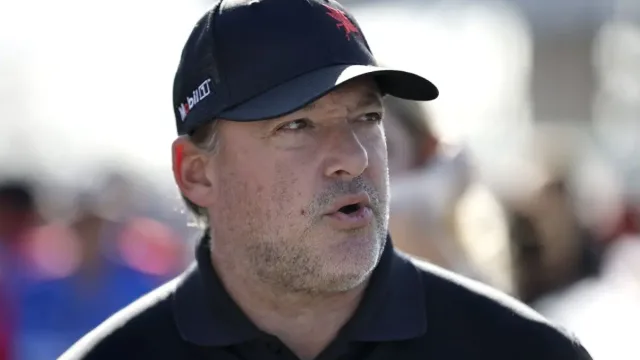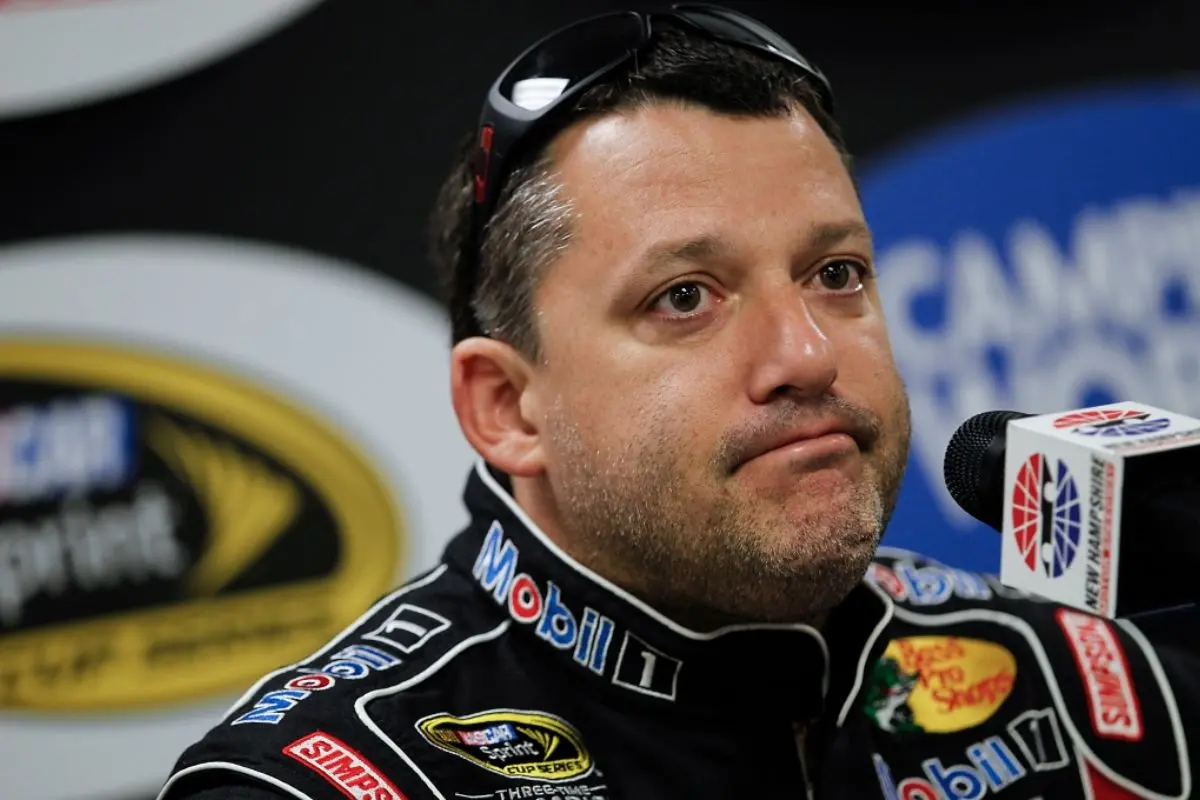Tony Stewart Doesn’t Care About His Own Team: Critiques from former Stewart-Haas Racing (SHR) members highlight Tony Stewart’s perceived detachment from the team, suggesting a troubling leadership void. Despite his charisma and expertise as a former driver, allegations have emerged regarding his lack of concern for employee welfare and performance. His irregular involvement has reportedly demoralized staff and hindered mentorship opportunities, especially for younger members.
Key Highlights
- Former SHR members have criticized Tony Stewart for a perceived lack of concern for team welfare and performance amid high-pressure environments.
- Stewart’s involvement with the team has created leadership vacuums, leading to uncertainty and declining employee morale.
- His charismatic approach may overshadow the essential personnel needs, resulting in internal struggles within the organization.
- The downturn in SHR’s performance and loss of key sponsors are seen as consequences of inconsistent leadership and engagement from Stewart.
- The impending closure of SHR highlights the importance of sustained commitment and investment in maintaining team success and morale.
Tony Stewart’s Impact on SHR
At the helm of Stewart-Haas Racing (SHR), Tony Stewart brings a distinctive leadership style that has particularly shaped the organization’s path in NASCAR. His approach to leadership is characterized by a blend of assertiveness and authenticity, allowing him to establish a unique culture within the team.
Stewart’s tenure as a driver-turned-owner has afforded him an intimate understanding of both the competitive landscape and the individual needs of his personnel, enabling him to make informed decisions that directly impact performance.
One of Stewart’s most substantial contributions to SHR is his emphasis on transparency and open communication. This fosters an environment where team members feel empowered to voice their ideas and concerns, cultivating a sense of ownership and accountability.
However, this frankness also creates a platform for potential friction, as open discussions can lead to conflict if not managed effectively. The duality of Stewart’s leadership style—both motivating and demanding—can sometimes lead to internal struggles, particularly when expectations run high.
Moreover, Stewart’s competitive nature drives a relentless pursuit of excellence, influencing both the culture and performance standards at SHR. His experience in high-pressure situations translates into a no-nonsense work ethic, compelling staff and drivers to enhance their game.
Joel Edmonds’ Reflections on Tony Stewart’s Leadership
Joel Edmonds, known for his frank insights on the Door Bumper Clear podcast, recently shared valuable reflections on Tony Stewart’s leadership that illuminate the inner workings of Stewart-Haas Racing (SHR).
During his forthright remarks in Phoenix, Edmonds provided a compelling analysis of the complexities and challenges that define Stewart’s management style. His perspective offers a rare glimpse into the operational dynamics often missed by fans and commentators similarly.
Edmonds emphasized the dichotomy between Stewart’s charisma and the underlying strain faced by the team. While Stewart is celebrated for his competitive spirit and passion for racing, Edmonds suggested that this intensity can sometimes overshadow the needs of the personnel.
He noted that Stewart’s leadership approach, while effective in fostering a strong competitive culture, may inadvertently create a high-stress environment that challenges team cohesion.
Moreover, Edmonds highlighted the importance of clear communication and support within the organization. He argued that, despite Stewart’s notable contributions to SHR’s success, there are moments when his focus on performance may lead to a disconnect with team members.
The Reality of Tony Stewart’s NASCAR Ownership
Tony Stewart’s ownership of Stewart-Haas Racing (SHR) represents a multifaceted reality that goes beyond mere competitive success on the track. While his driving accolades and business ventures have certainly shaped the team’s identity, the subtleties of his leadership style reveal a complex relationship with the personnel who make up the organization.
Insights from former SHR spotter Joel Edmonds highlight a recurring theme of absence and presence that greatly impacts team morale and cohesion. Edmonds, reflecting on his eight years with SHR, articulated a palpable frustration regarding Stewart’s sporadic involvement with the team. His comments suggest that while Stewart’s public persona is celebrated during victories, the behind-the-scenes dynamics require consistent engagement from leadership to foster a supportive environment.
“I saw Tony was there. Like, as soon as they won, he was hugging the crew guys and all that, which is kind of—a—I mean, I’m not taking a shot at him, but it’s kind of a slap in the face, you know? I was there six years. I don’t know how many times I saw the guy.” – Joel Edmonds
The contrast between Stewart’s celebratory presence after wins and his infrequent interactions during the season raises questions about the effectiveness of his leadership approach. In a sport that thrives on teamwork and constant communication, Edmonds’ perspective emphasizes the necessity of a leader’s active role.
“You’ve got to be present to win, and it’s not his fault for shutting down, probably.” – Joel Edmonds
Tony Stewart’s Absence and Leadership Challenges
Amidst the backdrop of NASCAR’s competitive landscape, the challenges posed by Tony Stewart’s absence from day-to-day operations at Stewart-Haas Racing (SHR) have become increasingly apparent.
“My first year, he was around a lot. The day my mom was having hip surgery in Charlotte, we were at the Roval, and he stood beside me that whole race at the Roval on the spotter stand.”
“I think you got there when he got sick of it. Yeah, well, and I understand the getting sick of it part because there are so many things that are not like they’re supposed to be.” – Joel Edmonds
Despite his status as a team owner, Stewart’s diminishing involvement has raised considerable leadership challenges that impact the team’s cohesion and performance.
- Leadership Vacuum: Stewart’s reduced presence has created a void in leadership, leading to uncertainty among team members regarding direction and decision-making.
- Shift in Focus: His growing engagement with NHRA and personal life commitments, particularly with his wife’s racing career and upcoming family, has diverted his attention away from SHR.
- Employee Morale: The lack of regular interaction, as highlighted by former employees, diminishes the sense of connection and morale within the team, which can affect general performance.
- Missed Opportunities for Mentorship: Stewart’s absence during critical moments, such as race days, limits opportunities for mentorship and growth among younger drivers and team personnel.
This multifaceted situation reflects a complex interplay of personal choices and professional responsibilities. While victories may still adorn SHR’s history, the reality is that effective leadership requires consistent engagement.
Without it, the team faces challenges that go beyond mere performance metrics, hinting at deeper organizational issues that could have lasting implications in the fiercely competitive world of NASCAR.
The Decline and Shutdown of Stewart-Haas Racing
The impending decline and shutdown of Stewart-Haas Racing (SHR) marks a remarkable turning point in NASCAR, reflecting the broader challenges faced by teams in an evolving competitive landscape. After nearly 15 years as a formidable contender, SHR’s decision to cease operations following the 2024 season highlights the difficulties of maintaining competitiveness amidst shifting dynamics.
The organization has grappled with a considerable downturn in performance, particularly after the retirements of key figures like Tony Stewart, Kevin Harvick, and Clint Bowyer. Last season, only one SHR driver qualified for the playoffs, illustrating a concerning trend of diminished on-track success.
This decline is compounded by a retreat of off-track support, as prominent sponsors such as Smithfield and Anheuser-Busch have redirected their investments to rival teams, further straining SHR’s financial viability.
Additionally, SHR’s partnership with Ford is nearing its termination, presenting further challenges in securing competitive resources. The shifting focus of both Tony Stewart and Gene Haas—toward NHRA and Formula One respectively—has ultimately led to a diminished commitment to NASCAR.
Their decision to step back, recognizing the intense commitment required to succeed in this hyper-competitive arena, suggests a tactical withdrawal rather than mere resignation.
News in Brief: Tony Stewart Doesn’t Care About His Own Team
The complexities surrounding Tony Stewart’s leadership at Stewart-Haas Racing reveal considerable challenges within the organization. Insights from former team members like Joel Edmonds emphasize a perceived disconnect between ownership and team dynamics.
The decline and eventual shutdown of SHR highlight the repercussions of absentee leadership in a competitive environment. Ultimately, the situation exemplifies the critical importance of consistent engagement and proactive management in maintaining a successful racing team, particularly in NASCAR.
ALSO READ: Tony Stewart Calls NASCAR Fans ‘Idiots’ for Attacking SHR’s Final Season Decision



